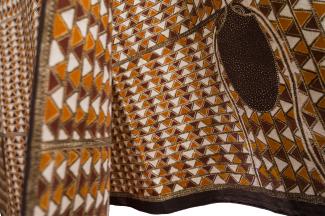Batik is a traditional process of applying wax and dyes to fabric to create intricate and colourful patterns. Often handed down within families for generations, the craft of batik is intertwined with the cultural identity of the Indonesian people. Their creativity and spirituality is expressed through the symbolic meanings of its colours and designs. Batik design has never stopped growing, continuously changing with the times and the culture of the people who make it.
The Yirrkala batik is an interpretation of bark paintings made by Ronald Nawurapu Wunungmurra, inspired by the Yolngu traditional songs which tell the story of Makassar (Bugis) sailors who visited Arnhem Land.
Collaborating across borders
The Yirrkala batik has triangular shaped motifs which represent the sails of a Bugis vessel sailing to Arnhem Land. The batik uses earthy natural colours of white and reddish-orange. It was made through a collaboration between the Yirrkala Arts Center in Arnhem Land, and the Galeri Buana Alit, a traditional batik maker in Pekalongan, Central Java. The batik was gifted to the Textile Museum in Jakarta by the Australian Embassy in a ceremony to mark National Aborigines and Islanders Day Observance Committee (NAIDOC) Week in 2015.
Ardi Hariyadi from the Textile Museum Jakarta shares the significance of the Yirrkala batik and connections between Makassar and northern Australia.

